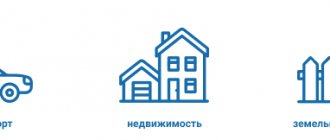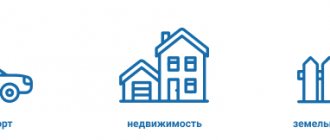Tax on real estate of individuals: objects of taxation
The corresponding object for the property tax of individuals may be (clause 1 of Article 401 of the Tax Code of the Russian Federation):
- separate residential building (including country houses);
- separate living space (in the form of an apartment or room);
- garage, parking space;
- building or structure for other purposes;
- unfinished construction;
- a complex of real estate objects of a single purpose.
The common real estate of an apartment building cannot be recognized as an object of taxation (clause 3 of Article 401 of the Tax Code of the Russian Federation).
What property deductions for personal income tax does the Tax Code provide for?
Property tax deduction for personal income tax is a state benefit established by the Tax Code, which allows an individual to return part of the tax paid.
An individual has the right to use this when selling property or purchasing (constructing) housing. Property personal income tax deductions are dealt with in Art. 220 Tax Code of the Russian Federation.
Conventionally, these deductions can be divided into those related to the sale of property (here, the deduction provided in connection with the seizure from the taxpayer of a land plot and/or a property located on it for state or municipal needs stands out) and those related to the construction or purchase of housing (land plot) .
Tax base for property tax for individuals
In 2021, the base for the tax under consideration is determined on the basis of the cadastral price of the objects we discussed above, if this is established by the legislative acts of the constituent entity of the Russian Federation (clause 1 of Article 402 of the Tax Code of the Russian Federation). If regional authorities have not adopted norms according to which the base is formed based on the cadastral price of real estate, then it is determined on the basis of the inventory value of objects, as long as this is permitted by law (clause 2 of Article 402 of the Tax Code of the Russian Federation). Since 2015, based only on the cadastral value, the base for the objects mentioned in paragraph 1 of Art. 378.2 of the Tax Code of the Russian Federation, if these objects are intended for use in business activities (clause 8 of Article 408, clause 3 of Article 402 of the Tax Code of the Russian Federation).
How to calculate property tax for individuals based on cadastral value? The answer to this question is in ConsultantPlus. If you do not have access to the K+ system, get a trial online access for free.
In general, the tax base for a particular property is equal to its cadastral value, except for those cases when the tax is paid (Article 403 of the Tax Code of the Russian Federation):
- per apartment - in this case, the cadastral base for it is reduced by the cadastral price of 20 sq. m in it (clause 3);
- room - in this case, the base for it is reduced by the cadastral price of 10 sq. m in it (clause 4);
- residential building - in this case, the base for it is reduced by the cadastral price of 50 square meters. m in it (clause 5);
- a single complex of real estate objects, including at least one residential premises or house - in this case, the base for it is reduced by 1,000,000 rubles. (clause 6).
Municipal legal acts may increase the amounts of the specified deductions that reduce the base for the tax in question (clause 7 of Article 403 of the Tax Code of the Russian Federation). If the use of a deduction leads to the formation of a negative value, the tax base will be equal to 0 (clause 8 of Article 403 of the Tax Code of the Russian Federation).
The base based on the inventory price is equal to the corresponding price multiplied by the deflator coefficient established by law.
Article 399. General provisions
1. The property tax for individuals (hereinafter referred to as the tax in this chapter) is established by this Code and the regulatory legal acts of the representative bodies of municipal formations, is put into effect and ceases to be in effect in accordance with this Code and the regulatory legal acts of the representative bodies of municipal formations and is obligatory for payment in the territories of these municipalities.
In the federal cities of Moscow, St. Petersburg and Sevastopol, the tax is established by this Code and the laws of the specified constituent entities of the Russian Federation, is put into effect and ceases to be in effect in accordance with this Code and the laws of the specified constituent entities of the Russian Federation and is obligatory for payment in the territories of these constituent entities of the Russian Federation.
2. When establishing a tax, the representative bodies of municipalities (legislative (representative) bodies of state power of the federal cities of Moscow, St. Petersburg and Sevastopol) determine tax rates within the limits established by this chapter, and the specifics of determining the tax base in accordance with this chapter.
When establishing a tax, regulatory legal acts of representative bodies of municipalities (laws of federal cities of Moscow, St. Petersburg and Sevastopol) may also establish tax benefits not provided for by this chapter, the grounds and procedure for their application by taxpayers.
Personal property tax: rates
To calculate tax based on cadastral and inventory values, different rates are applied. In both cases, they can be established by regional authorities - but within the limits reflected in the Tax Code of the Russian Federation.
According to the cadastral base, rates can be set at no more than (clause 2 of Article 406 of the Tax Code of the Russian Federation):
- 0.1%, if the object of taxation is a house, residential premises, unfinished construction, a single complex in which there is at least one residential premises or house, a garage, a parking space, a building in a country house with an area of up to 50 square meters. m;
- 2%, if the object of taxation is determined in accordance with the conditions of paragraphs. 7, 10 tbsp. 378.2 of the Tax Code of the Russian Federation or has a cadastral value of more than 300,000,000 rubles;
- 0.5% - for any other objects.
Rates based on the cadastral base are accepted in the region in the amount specified in the Tax Code of the Russian Federation, unless other rates are established by the law of the region (subclause 1, clause 6, Article 406 of the Tax Code of the Russian Federation). Moreover, the region has the right to reduce (down to zero) or increase (but no more than 3 times) the rate for objects that, according to the Tax Code of the Russian Federation, are taxed at a rate of 0.1% (clause 3 of Article 406 of the Tax Code of the Russian Federation).
According to the inventory base, rates can be set at no more than (clause 4 of Article 406 of the Tax Code of the Russian Federation):
- 0.1% if the inventory value of the object, taking into account the deflator coefficient, does not exceed 300,000 rubles;
- 0.1–0.3%, if the inventory value of the object, taking into account the deflator coefficient, is 300,000–500,000 rubles;
- 0.3–2%, if the inventory value of the object, taking into account the deflator coefficient, exceeds RUB 500,000.
If the rates for the inventory base are not determined by the law of the region, then their value will be (subclause 2, clause 6, article 406 of the Tax Code of the Russian Federation):
- 0.1% if the inventory value of the object does not exceed 500,000 rubles;
- 0.3% if the inventory value is more than 500,000 rubles.
Regional authorities have the right to differentiate rates for both bases for objects of the same category, but different (clause 5 of Article 406 of the Tax Code of the Russian Federation):
- cadastral (inventory) value;
- type of object;
- location;
- specifics of the territorial zone in which they are located.
Procedure for calculating property tax for individuals
In order to calculate tax in a region where laws on calculating tax based on cadastral prices have been adopted (the majority of such constituent entities of the Russian Federation), you need to know:
- cadastral and inventory price of the property;
- rates - cadastral and inventory;
- deflator value;
- object area;
- values of reduction coefficients;
- Are tax benefits applicable to tax calculation?
Find out what benefits are provided for property tax for individuals in ConsultantPlus. Get free demo access to K+ and get tips from the experts.
When calculating the tax, if for the region it turns out to be the 5th year of the beginning of the application of the calculation from the cadastral value, it will not be necessary to take into account in the formula for its calculation:
- inventory value, as well as the rate that is set for it;
- deflator;
- reduction factor.
Property tax for individuals is calculated using a special formula established by the Tax Code of the Russian Federation. For a full year of property ownership, it looks like this (clause 8 of Article 408 of the Tax Code of the Russian Federation):
H = (H1 - H2) × K + H2,
Where:
N - calculated property tax.
N1 - tax according to the cadastral base.
N2 - tax based on the inventory base, calculated for the year preceding the beginning of the introduction in the region of calculating the tax on the cadastral value. For 2014, it is determined according to the rules of the Law “On Taxes on Personal Property” dated December 9, 1991 No. 2003-I, which ceased to be in effect in 2015, and for later periods of the beginning of the introduction in the region of tax calculation based on cadastral value - according to the rules of the law region that was in effect in the year preceding the start of calculating the tax on the cadastral value.
K is a reduction coefficient, the value of which increases consistently during the first 4 years of the introduction in the region of calculating tax from the cadastral value, amounting to 0.2, respectively; 0.4; 0.6 and 0.8.
That is, from the 5th tax period, tax will be charged on the cadastral value in full. Since, from 2021, tax calculation other than the cadastral value will be discontinued, in regions that began to do it later than 2021, they will not be able to use the right to apply reduction coefficients to the fullest extent.
We can consider how this formula is applied by studying a practical example of calculating the amount of tax.
Article 409. Procedure and terms for payment of tax
1. The tax must be paid by taxpayers no later than December 1 of the year following the expired tax period.
2. The tax is paid at the location of the object of taxation on the basis of a tax notice sent to the taxpayer by the tax authority.
3. Sending a tax notice is allowed no more than three tax periods preceding the calendar year of its sending.
4. The taxpayer pays tax for no more than three tax periods preceding the calendar year of sending the tax notice.
5. Refund (credit) of the amount of overpaid (collected) tax in connection with the recalculation of the tax amount is carried out for the period of such recalculation in the manner established by Articles 78 and 79 of this Code.
An example of calculating the amount of property tax for individuals
Let's assume that you need to calculate tax for 2021:
- we started paying property taxes in 2021 and have the right to apply a reduction factor of 0.2;
- we do not have tax benefits (we will study their specifics a little later);
- we have an apartment of 70 sq. m;
- the cadastral price of the apartment is 2,000,000 rubles, the inventory price is 300,000 rubles;
- we live in Kazan, where there is a rate of 0.2% for the cadastral base (decision of the Kazan City Duma dated November 20, 2014 No. 3-38) and 0.1% for the inventory base at a cost of less than 500,000 rubles. taking into account the deflator (the norms of the Tax Code of the Russian Federation are in force, the regional normative legal act has not been adopted).
The result of calculations is determined in whole rubles.
First of all, we consider the H1 indicator. For this:
1. Calculate the size of the cadastral tax base:
- divide 2,000,000 (real estate cost) by 70 (apartment area), we get 28,571 rubles;
- subtract from 70 sq. m "apartment" deduction in the amount of 20 sq. m, it turns out 50 sq. m;
- multiply the first result by the second, it turns out 1,428,550 rubles.
2. We determine the H1 indicator by multiplying the cadastral base by a rate of 0.2%. It turns out 2,857 rubles.
Next, we calculate the indicator H2. To do this, we apply a rate of 0.1% to the inventory base, calculated taking into account the deflator coefficient for 2014:
H2 = 300,000 × 1.216 × 0.1% = 365 rubles.
Next we proceed according to the formula:
1. We subtract inventory N2 from the cadastral tax N1, it turns out 2,492 rubles.
2. We multiply the resulting result by the reduction factor established for the first year of application of the calculation in question, and we get 498 rubles.
3. Add inventory tax N2 to it, it turns out 863 rubles.
Thus, the property tax payable for 2021 will be 863 rubles.
We noted above that when calculating property taxes for individuals, benefits can be taken into account. Let's study this aspect in more detail.
For whom personal property tax is not mandatory?
In general, the payers of this tax are all individuals who own the objects we discussed at the beginning of the article. But some categories of citizens have property tax benefits. The list of these categories is fixed in the provisions of paragraph 1 of Art. 407 of the Tax Code of the Russian Federation.
If a citizen has the appropriate status, then he is exempt from paying property tax - but only for one object of taxation of each type (for example, 1 apartment, 1 house, 1 garage). If there are several objects of the same type, the person himself chooses which of them will not be subject to tax. By default, the Federal Tax Service, when calculating tax, selects the most expensive object from several for preferential treatment.
For more information about who is entitled to real estate tax benefits for individuals, as well as about calculating the tax for an incomplete period of ownership of property, read the article “Property tax - an unfinished construction project.”
Article 407. Tax benefits
COMMENT For details on who is entitled to receive tax benefits and how to apply for them, see the link.
1. Taking into account the provisions of this article, the following categories of taxpayers have the right to a tax benefit:
1) Heroes of the Soviet Union and Heroes of the Russian Federation, as well as persons awarded the Order of Glory of three degrees;
2) disabled people of disability groups I and II;
3) disabled since childhood, disabled children;
4) participants in the Civil War, the Great Patriotic War, and other military operations to defend the USSR from among military personnel who served in military units, headquarters and institutions that were part of the active army, and former partisans, as well as combat veterans;
5) civilian personnel of the Soviet Army, Navy, internal affairs and state security bodies who held regular positions in military units, headquarters and institutions that were part of the active army during the Great Patriotic War, or persons who were in military service during this period cities, participation in the defense of which is counted towards these persons' length of service for the purpose of granting a pension on preferential terms established for military personnel of active army units;
6) persons entitled to receive social support in accordance with the Law of the Russian Federation of May 15, 1991 No. 1244-I “On the social protection of citizens exposed to radiation due to the disaster at the Chernobyl nuclear power plant”, in accordance with the Federal Law of November 26, 1998 year No. 175-FZ “On the social protection of citizens of the Russian Federation exposed to radiation as a result of the accident in 1957 at the Mayak production association and the discharge of radioactive waste into the Techa River” and Federal Law of January 10, 2002 No. 2-FZ “On social guarantees to citizens exposed to radiation as a result of nuclear tests at the Semipalatinsk test site";
7) military personnel, as well as citizens discharged from military service upon reaching the age limit for military service, health conditions or in connection with organizational and staffing events, having a total duration of military service of 20 years or more; 2 Federal benefits for property tax for individuals ;
persons who were directly involved as part of special risk units in testing nuclear and thermonuclear weapons, eliminating accidents of nuclear installations at weapons and military facilities;
9) family members of military personnel who have lost their breadwinner, recognized as such in accordance with Federal Law No. 76-FZ of May 27, 1998 “On the status of military personnel”;
10) pensioners receiving pensions assigned in the manner established by pension legislation, as well as persons who have reached the ages of 60 and 55 years (men and women, respectively), who, in accordance with the legislation of the Russian Federation, are paid a monthly lifelong allowance;
11) citizens discharged from military service or called up for military training who performed international duty in Afghanistan and other countries where hostilities took place;
12) individuals who received or suffered radiation sickness or became disabled as a result of tests, exercises and other work related to any types of nuclear installations, including nuclear weapons and space technology;17
13) parents and spouses of military personnel and government employees who died in the line of duty;
14) individuals carrying out professional creative activities - in relation to specially equipped premises, structures used by them exclusively as creative workshops, ateliers, studios, as well as residential buildings, apartments, rooms used to organize non-state museums and galleries open to the public , libraries - for the period of such use;
15) individuals - in relation to economic buildings or structures, the area of each of which does not exceed 50 square meters and which are located on land plots provided for personal subsidiary farming, dacha farming, vegetable gardening, horticulture or individual housing construction.
2. A tax benefit is provided in the amount of tax payable by the taxpayer in relation to an object of taxation that is owned by the taxpayer and is not used by the taxpayer in business activities.
3. When determining the amount of tax payable by a taxpayer, a tax benefit is provided in respect of one taxable item of each type at the taxpayer’s choice, regardless of the number of grounds for applying tax benefits.
4. Tax benefits are provided in relation to the following types of taxable items:
- apartment, part of an apartment or room;
- residential building or part of a residential building;
- premises or structures specified in subparagraph 14 of paragraph 1 of this article;
- economic building or structure specified in subparagraph 15 of paragraph 1 of this article;
- garage or parking space.
5. Tax benefits are not provided in respect of taxable objects specified in subparagraph 2 of paragraph 2 of Article 406 of this Code, with the exception of garages and parking spaces located in such taxable objects.
6. Individuals entitled to tax benefits established by the legislation on taxes and fees submit an application for a tax benefit to the tax authority of their choice, and also have the right to submit documents confirming the taxpayer’s right to a tax benefit.
Confirmation of a taxpayer's right to a tax benefit is carried out in a manner similar to the procedure provided for in paragraph 3 of Article 361.1 of this Code.
The form of an application for a tax benefit and the procedure for filling it out, the format for submitting such an application in electronic form are approved by the federal executive body authorized for control and supervision in the field of taxes and fees.
7. A notification about the selected objects of taxation in respect of which a tax benefit is granted is submitted by the taxpayer to the tax authority of his choice before November 1 of the year, which is the tax period from which the tax benefit is applied to the specified objects.
A taxpayer who has submitted a notification to the tax authority about the selected taxable object does not have the right, after November 1 of the year that is the tax period, to submit an updated notification with a change in the taxable object in respect of which a tax benefit is granted in the specified tax period.
If a taxpayer entitled to a tax benefit fails to provide notice of the selected taxable item, the tax benefit is granted in respect of one taxable item of each type with the maximum calculated tax amount.
The form of the notification is approved by the federal executive body authorized for control and supervision in the field of taxes and fees.






